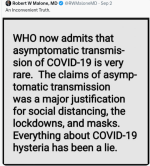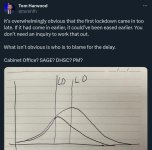You are using an out of date browser. It may not display this or other websites correctly.
You should upgrade or use an alternative browser.
You should upgrade or use an alternative browser.
The coronavirus scam
- Thread starter Jefferson
- Start date
way 2 go
Well-known member

☕️ JACKPOT ☙ Tuesday, August 8, 2023 ☙ C&C NEWS 🦠
A special single-issue roundup about a blockbuster new study that probably just blew the lid off the government’s covid coverup. Strap in, this might be the most important C&C post this year.
The puzzle pieces continue to fall into place, and a significant new puzzle piece dropped last week, in the form of a preprint published to MedRxIV on July 31st, titled “SARS-CoV-2 Uses CD4 to Infect T Helper Lymphocytes.”
Although “just” a preprint, it features no fewer than seventy-seven authors. And it has already gathered three positive peer reviews. Let’s start with their conclusion, and then try to unpack what it means. The study’s admittedly obscure conclusion:
We demonstrated that SARS-CoV-2 spike glycoprotein (S) directly binds to the CD4 molecule, which in turn mediates the entry of SARS-CoV-2 in T helper cells. This leads to impaired CD4 T cell function and may cause cell death. SARS-CoV-2-infected T helper cells express higher levels of IL-10, which is associated with viral persistence and disease severity. Thus, CD4-mediated SARS-CoV-2 infection of T helper cells may contribute to a poor immune response in COVID-19 patients.
Not to beat a dead horse, but CD4 cells are especially important in coordinating the immune response against infections, and they are central to the body's ability to remember and respond to specific pathogens. However, certain viruses, like HIV, specifically target and infect CD4 cells themselves, thereby knocking out the frontline immune response and weakening the overall immune system — which alarmingly creates increased vulnerability to other opportunistic infections.
Opportunistic infections like monkeypox, Hansen’s disease, RSV, and so on. Just to name a few, at random.
So what does all this mean, beyond a weakened immune system? The researchers speculated:
In other words, the spike protein’s CD4-attacking feature seems almost designed to avoid the human immune response. Just what you’d want in a bioweapon, for example.Infection of CD4+ T cells by SARS-CoV-2 could explain lymphocytopenia and dysregulated inflammatory response in severe COVID-19 patients. Moreover, from an evolutionary perspective, infection of CD4+ T cells represents an effective mechanism for viruses to escape the immune response.
Once inside the CD4 cell, the covid virus weakens and kills it, destroying part of the immune system each time it happens. Worse, this process increases systemic levels of an inflammatory cytokine called Interleukin-10 (IL-10 ), which is associated with “viral persistence,” meaning an IL-10 inflammation makes it harder for the body to clear an infection. So covid — specifically its spike protein — hits the immune system two different ways.
Ultimately, the authors conceded that we don’t know how long the effect lasts:
way 2 go
Well-known member

☕️ QUID PRO JOE ☙ Saturday, August 26, 2023 ☙ C&C NEWS 🦠
Fired Shokin to talk on Fox; Atlantic whiffs on mug shot; pedo relatives sue Kyle Rittenhouse; costs of the Proxy War; WHO/IMF vaccine plot; great disinformation story; variable sentencing; more.
Channel News Asia ran an unintentionally revealing story yesterday, headlined “Preparing for the next pandemic requires ‘new way of thinking about international cooperation’: Tharman.”

On Wednesday, WEF darling and Singaporean presidential candidate Tharman Shanmugaratnam, if that’s his real name, gave a joint press conference with WHO director-general Tedros Ghebreyesus, beginning with the outrageous fib that the World Health Organization is “dangerously underfunded.”
Don’t make me laugh.
After issuing a typical globalist demand for a plenary, collectivist “health” authority that can override individual nations’ sovereignty, for “safety,” Shanmugaratnam moved glibly into another area he knows nothing about, vaccines.
Ominously, Singapore’s likely next president and top WHO official first noted the “uptick” in covid numbers, and then revealed a very disturbing fact: the WHO and the IMF have brewed-up a brand-new vaccine action plan. "The first and most urgent priority is to implement the action plan set out by the WHO, IMF and their multilateral partners to vaccinate at least 60 per cent of every country’s population over the next year,” Shanmugaratnam gushed.
Sixty percent. Of the entire world. For covid. I am not making that up.
According to Channel News, Shanmugaratnam explained that the world is “vulnerable” to both a “prolonged COVID-19 pandemic,” with repeated waves affecting all countries, as well as future pandemics. "We can fix this," he whispered darkly, like a cartoon super-villain preparing to unleash an army of laser-equipped Mako sharks.
Repeated waves? Sounds a lot like influenza. Shanma-whatever didn’t explain how the useless vaccines that don’t stop transmission are supposed to prevent a “prolonged pandemic” with “repeated waves” in the first place. Maybe they should first start with something easier, like beating the common cold.
So anyway, it looks they are gearing up for another big jab push. I say good luck to them, they’ll need it. Unlike last time, we’re ready for them now.
SaulToPaul 2
Well-known member
Still unjabbed, I kept livin my life
Me too.Still unjabbed, I kept livin my life
ok doser
lifeguard at the cement pond
I was cleaning out the drawer under my passenger's seat in my car and ran across a bundle of old masks that I never wore. Went maskless as much as I could and avoided (thanks to a sympathetic manager) the "mandatory" jab in Year two.Still unjabbed, I kept livin my life
Haven't had as much as a sniffle in 5 years
Right Divider
Body part
Me too!Me too.
Right Divider
Body part
Well, that didn't age very well. Anyone who hasn't seen The Plandemic parts one and two needs to. It's literally a matter of life and death.I've pretty much given up on this site. I only hang around here to counter the COVID conspiracy nonsense. You will never convince some people of reality. Their alternate reality is part of their identity.
I live in Israel, where the vaccine has been a great success. I urge everybody to get vaccinated, as soon as possible.
Last edited:
...and then there's Alex. I have never understood why interviewers continually interrupt their guests mid point and try to steer the conversation where they want it to go if they are genuinely interested in what they have to say in the first place.Sean Hannity is even worse about interrupting like that.
ok doser
lifeguard at the cement pond
Tucker / Brett Weinstein interview. Haven't listened to it yet but scanned this article quickly.

 brownstone.org
brownstone.org

Reflections on the Bret Weinstein Interview ⋆ Brownstone Institute
Tucker Carlson has conducted a brilliant interview with biologist and podcaster Bret Weinstein, who has been on the Covid case for a very long time. Weinstein speaks with erudition, expertise, and great precision about a number of features of the Covid response.
 brownstone.org
brownstone.org











